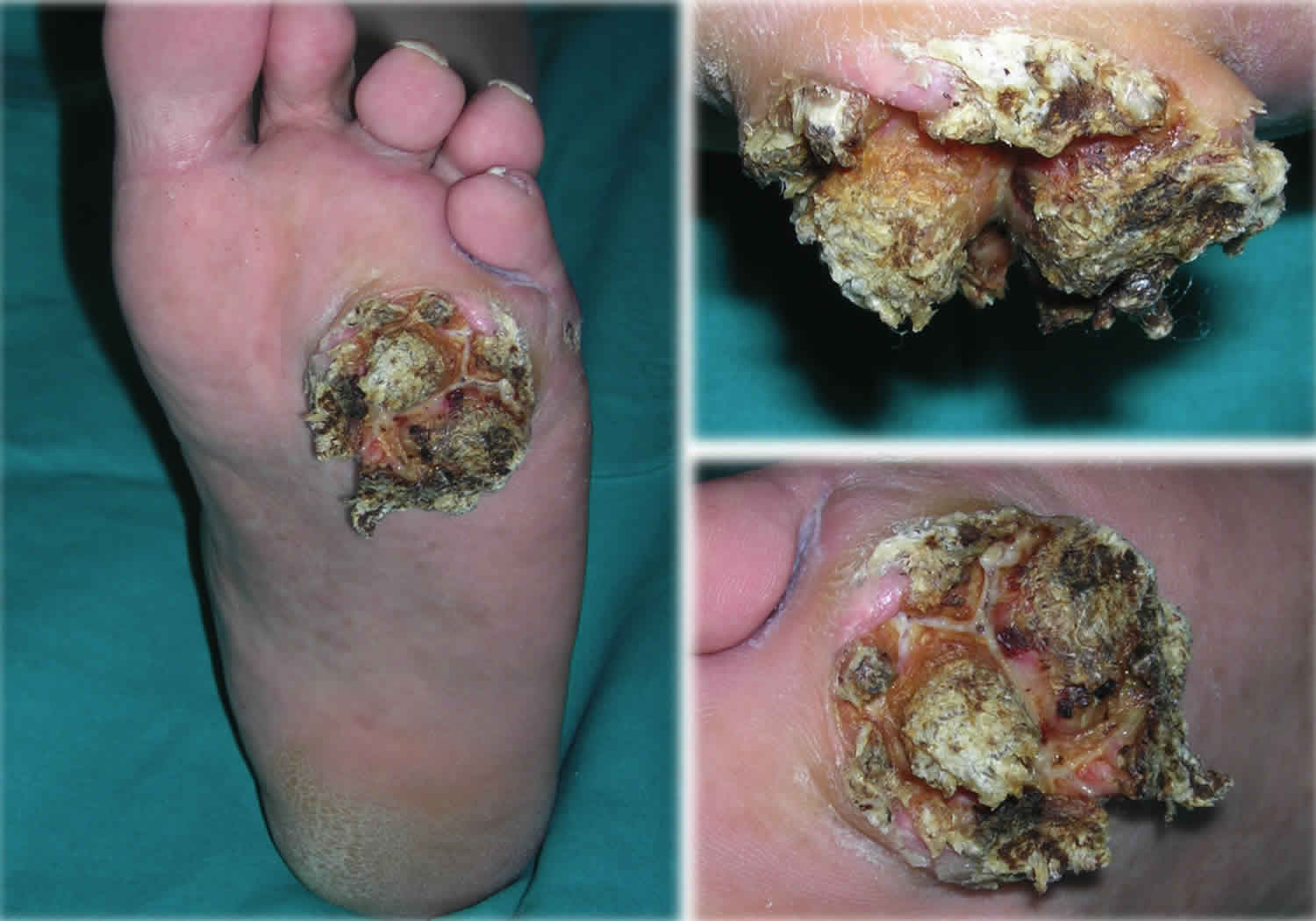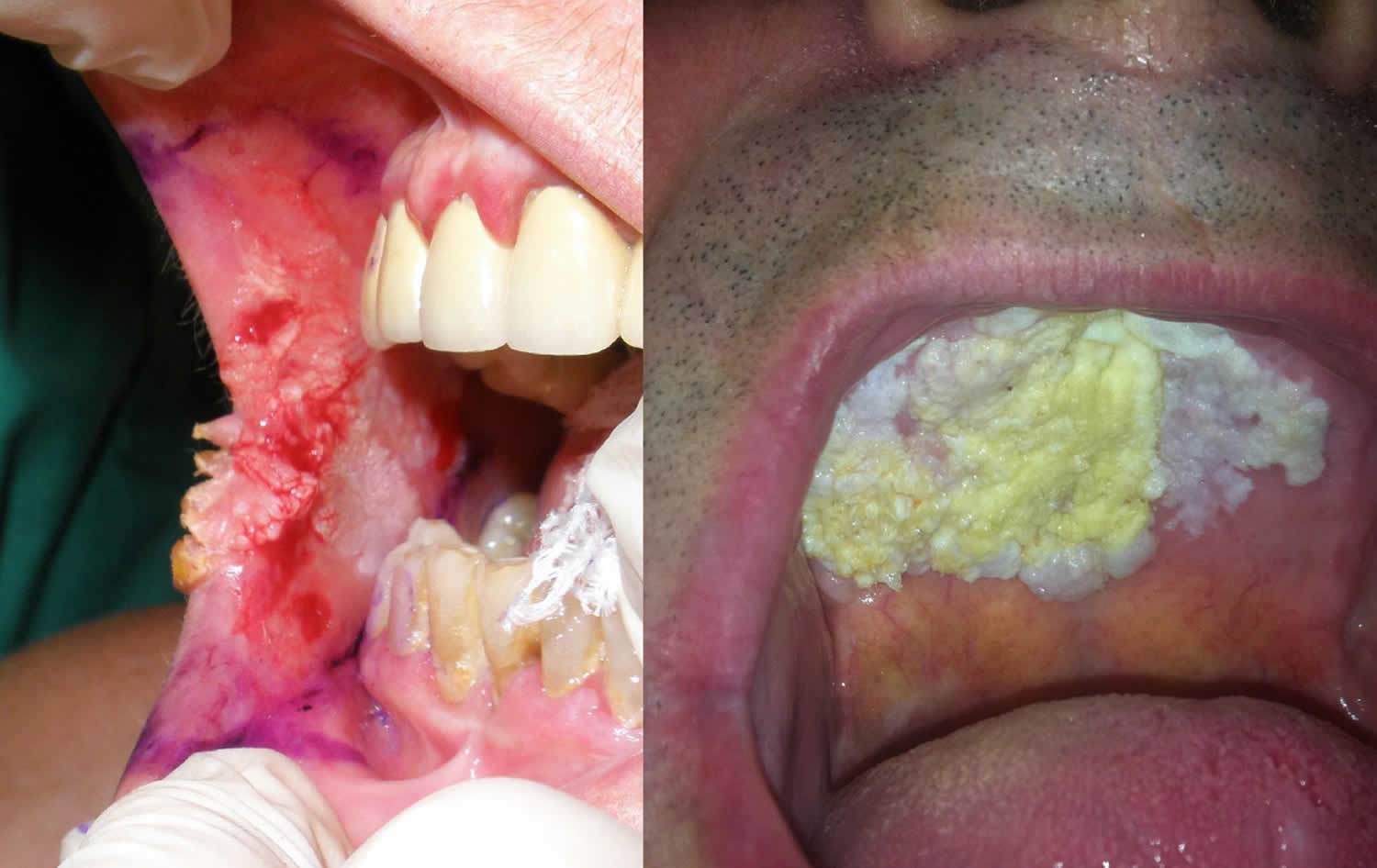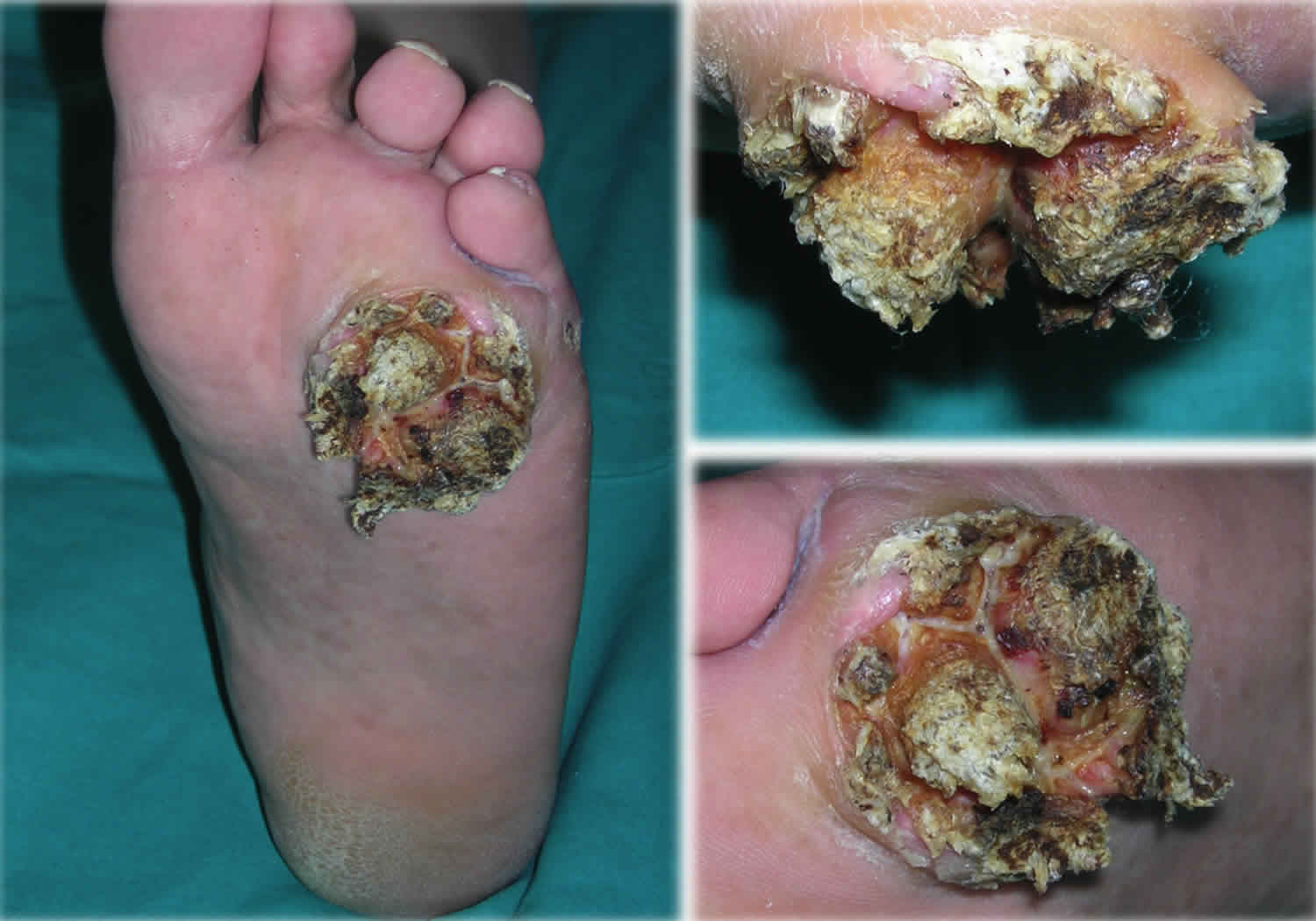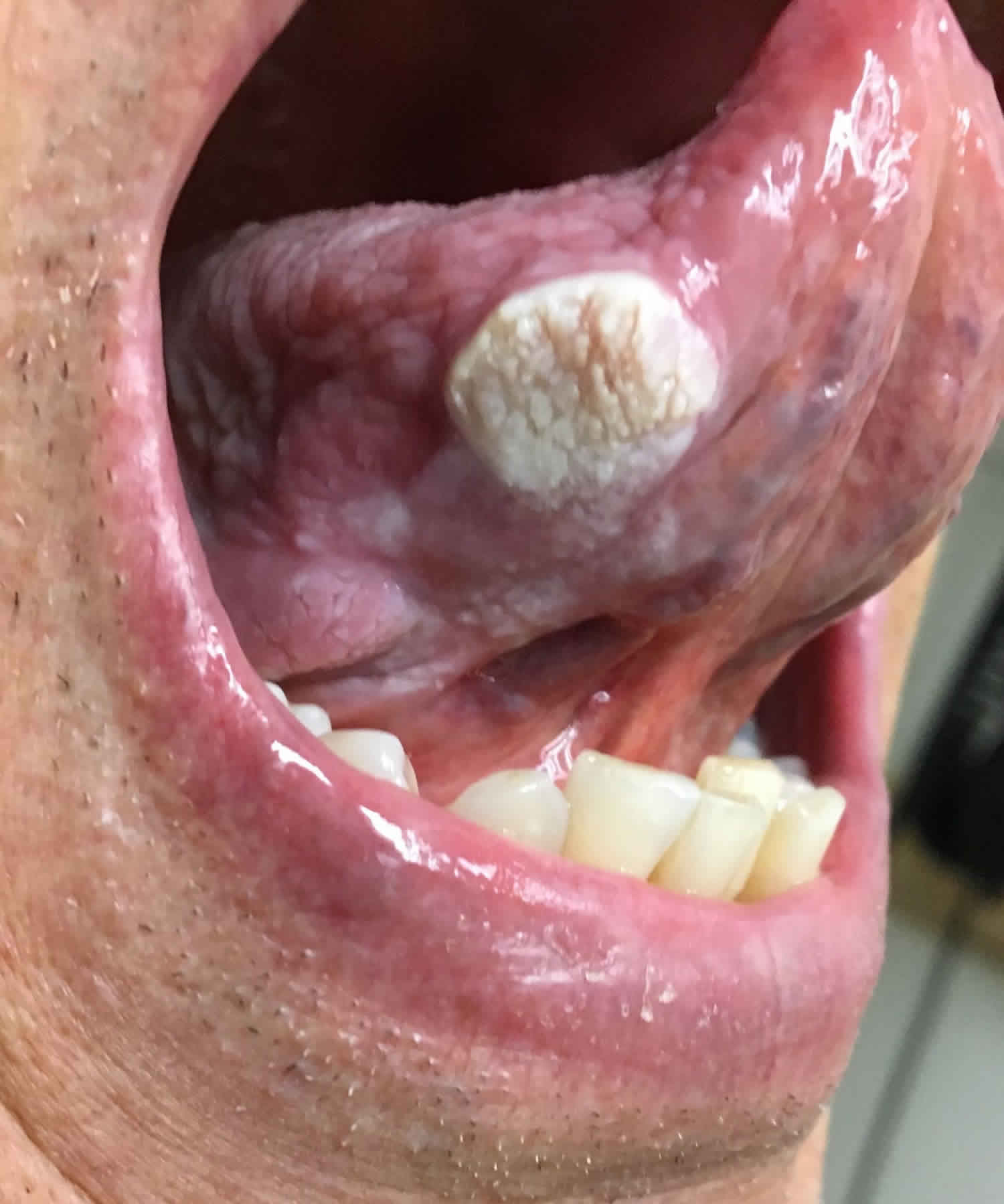What is verrucous carcinoma
Verrucous carcinoma is also called carcinoma cuniculatum, epithelioma cuniculatum, Ackerman tumor, Buschke–Löwenstein tumor or Buschke–Löwenstein tumor, is a rare, slow-growing locally aggressive clinically exophytic and well-differentiated variant of cutaneous squamous cell carcinoma (SCC) with minimal metastatic potential. Verrucous carcinoma tends to affect the sole of the foot, but it can occur at other sites, such as the oral cavity and genitals.
Risk factors for verrucous carcinoma include viral warts due to human papillomavirus infection (HPV), tobacco (smoking or snuff), chemical mutagens, and in the vulva, lichen sclerosus 1. The genital variant tends to affect older people.
Figure 1. Verrucous carcinoma oral
Figure 2. Verrucous carcinoma foot
Figure 3. Verrucous carcinoma tongue
What causes verrucous carcinoma?
Human papillomavirus (HPV) may play a role in the development of verrucous carcinoma 2. HPV types 6 and 11 are most frequently associated with the verrucous carcinoma 3. In plantar lesions, HPV type 16 has been reported 4. Finally, HPV type 33 has been reported in a verrucous carcinoma of the scalp 5.
Despite the presence of HPV strains within some lesions of verrucous carcinoma, a causal relationship has not been proven and remains controversial 6.
Inflammation appears to sometimes play a role in the development of verrucous carcinoma. For instance, cutaneous verrucous carcinoma may develop at sites of inflammation or scarring such as decubitus ulcers or areas affected by hidradenitis suppurativa 7. In addition, lichen sclerosus may predispose patients to the development of penile verrucous carcinomas 8. Similarly, verrucous carcinomas of the oral cavity have been reported to develop in patients with long-standing oral ulcerative lichen planus and chronic candidiasis.
Associations in oral verrucous carcinoma have been found in patients who chewed or inhaled tobacco and betel nuts, dipped snuff, and/or consumed alcohol. Lesions developed at the sites where tobacco was habitually placed in the mouth 9.
Furthermore, oral verrucous carcinoma is associated with poor dental hygiene, ill-fitting dentures, and low socioeconomic status. Oral verrucous carcinoma has a higher incidence in males and in immunocompromised patients 9.
Schistosomal infection often is coexistent with verrucous carcinoma of the bladder 10.
Verrucous carcinoma signs and symptoms
Carcinoma cuniculatum is a solitary, slow growing, warty, papillomatous plaque.
- It usually develops on the foot, oral cavity, nails, or genitals.
- It rarely ulcerates.
- When located on the foot, lesions are usually found on the sole of the foot (53%), toes (21%), or heel (16%) 11.
- On the penis, it accounts for < 1% of all squamous cell carcinoma (SCC) variants.
- In the oral cavity, it can appear as a warty white neoplasm 12.
Verrucous carcinoma complications
In rare cases, verrucous carcinoma can metastasise.
Verrucous carcinoma diagnosis
Although the diagnosis of verrucous carcinoma may be suspected clinically, a good-sized incisional biopsy is required is essential to confirm the diagnosis. Superficial / small biopsies are unsatisfactory and can provide false negative results.
Verrucous carcinoma treatment
Whilst verrucous carcinoma is considered to have a very low incidence of metastases, tumors can invade the underlying structures such as bone, cartilage and tendons, accordingly surgical excision is regarded as first-line treatment. Recurrence rates of 19% have been reported.
Verrucous carcinoma is usually treated by surgical excision. Moh’s technique, under which microscopically controlled dissection allows total tumor removal with maximum preservation of normal tissue structure, has been reported to be successful in patients with verrucous carcinoma.
Amputations are necessary when the tumor is too extensive or recurs after multiple attempts of local excision. According to the literature, amputations were more likely to be performed when the tumor infiltrates the soft tissue between metatarsal heads or there is evidence of possible bony involvement on imaging. In these cases, it becomes impractical to perform local excision with good clearance margins.
Oral retinoids, methotrexate, laser surgery, and topical imiquimod have been reported to be effective where surgery is contraindicated 12.
Radiotherapy is to be avoided, as this can trigger the development of an anaplastic form of squamous cell carcinoma (SCC).
Long-Term Monitoring
Verrucous carcinoma usually is cured with appropriate therapy. However, recurrence of cutaneous carcinoma with clear surgical margins has been reported. In addition, patients with a history of verrucous carcinoma should be evaluated with regular skin examinations at 3- to 12-month intervals.
Verrucous carcinoma prognosis
Overall, patients with verrucous carcinoma have a favorable prognosis, although the course of verrucous carcinoma lesions is characterized by slow, continuous, local growth. Morbidity results from local skin and soft-tissue destruction and, occasionally, from perineural, muscle, and even bone invasion. The development of distant metastases is rare. Verrucous carcinoma mortality usually is due to local invasion rather than metastatic spread.
In most cases of verrucous carcinomas, regardless of the variant, the clinical outcome is rarely an aggressive course. Local verrucous carcinoma recurrence following definitive treatment is not uncommon. Regarding oral verrucous carcinoma, the reported recurrence rate ranges from 6-40%. If metastasis does occur, it is mainly at the regional lymph nodes 9. There have been reports of metastases in distant sites, but this is considered rare. In long-standing lesions, occasional destruction of adjustment structures such as cartilage, tendons, and bones can occur. Patients with oral verrucous carcinoma may be at an increased risk of a second primary oral squamous cell carcinoma, which carries a poor prognosis.
References- De Berker. Acquired disorders of the nails and nail unit. In: Griffiths C, Barker J, Bleiker T, Chalmers R, Creamer D (eds). Rook’s textbook of dermatology. 9th edn, vol 3. Oxford: Wiley-Blackwell Scientific Publications, 2016: chapter 95.
- Verrucous carcinoma. https://emedicine.medscape.com/article/1101695-overview
- Schwartz RA. Verrucous carcinoma of the skin and mucosa. J Am Acad Dermatol. 1995 Jan. 32(1):1-21.
- Schell BJ, Rosen T, Rady P, et al. Verrucous carcinoma of the foot associated with human papillomavirus type 16. J Am Acad Dermatol. 2001 Jul. 45(1):49-55.
- Murao K, Kubo Y, Fukumoto D, Matsumoto K, Arase S. Verrucous carcinoma of the scalp associated with human papillomavirus type 33. Dermatol Surg. 2005 Oct. 31(10):1363-5.
- Odar K, Kocjan BJ, Hošnjak L, Gale N, Poljak M, Zidar N. Verrucous carcinoma of the head and neck – not a human papillomavirus-related tumour?. J Cell Mol Med. 2014 Apr. 18(4):635-45.
- Cosman BC, O’Grady TC, Pekarske S. Verrucous carcinoma arising in hidradenitis suppurativa. Int J Colorectal Dis. 2000 Nov. 15(5-6):342-6.
- Nasca MR, Innocenzi D, Micali G. Penile cancer among patients with genital lichen sclerosus. J Am Acad Dermatol. 1999 Dec. 41(6):911-4.
- Walvekar RR, Chaukar DA, Deshpande MS, et al. Verrucous carcinoma of the oral cavity: A clinical and pathological study of 101 cases. Oral Oncol. 2009 Jan. 45(1):47-51.
- Blackmore CC, Ratcliffe NR, Harris RD. Verrucous carcinoma of the bladder. Abdom Imaging. 1995 Sep-Oct. 20(5):480-2.
- Cunliffe T. Carcinoma cuniculatum. Primary Care Dermatological Society. Updated April 2018. http://www.pcds.org.uk/clinical-guidance/verrucous-carcinoma
- Scully C. Dermatoses of the oral cavity and lips. In: Griffiths C, Barker J, Bleiker T, Chalmers R, Creamer D (eds). Rook’s textbook of dermatology. 9th edn, vol 3. Oxford: Wiley-Blackwell Scientific Publications, 2016: chapter 110.








